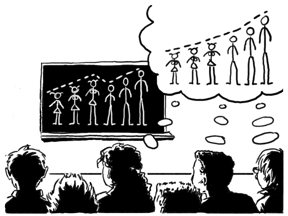Why Don't They Hear What I Say?

Have you ever felt as though you're shouting and no one hears; that your good research on gender and science is ignored by policy makers, teachers, and parents who all too often fall back on myths and stereotypes about gender? Why do so many people refuse to learn from your research? The answer lies in how people think about gender. Like any topic, knowledge about gender and gender differences is structured into systems. These systems have ways of protecting themselves. New information often has trouble getting incorporated unless it connects to the system in the right place. Here we look at some qualities that characterize beliefs about gender.
Join us as we follow...
The frustrating adventures of Dr. X!!
The frustrating adventures of Dr. X!!

Dr. X just finished a project on height. She measured the heights of lots of people and investigated lots of correlates, including age, sex, parentsí height, childhood nutrition, early exercise patterns. . . She found many interesting patterns but wherever she goes, she hears people quoting her study as showing that men are taller than women.
Yes in her study the mean height for men was significantly greater than the mean height for women. But there's also a lot of overlap. In fact, half of all men and half of all women fell between 64 and 70 in. in height!1 But no one ever seemed to quote that aspect of her study. Dr. X made some graphs and traveled around trying to teach people about the complexities of height. But she never really had an impact.
Why didn't they hear her?
Dr. X was running into a gender ideology. Much of the time, when people talk about gender differences, they're not talking about specific empirical claims. Instead, they are drawing on and contributing to a complex mix of beliefs about the way the world is, the way the world should be, and the way we should be in the world. People accept knowledge from different sources for different reasons. Producing and sharing research about gender (and lots of other things!) is more than just reporting your results. It means engaging in an ongoing conversation about gender and how we decide what to believe. Gender ideologies have certain qualities that are useful to understand if you're a part of this conversation.
- Ideologies often are tied to each other: the idea that men are taller and women shorter connects to images of men as stronger, faster, and more energetic. These all in turn connect with ideas about men as aggressive or more responsible for physical defense. That means when challenging one ideology, you often quickly get tangled in several more!
- Ideologies can withstand a lot of counterevidence, because they are often recursive.2 Recursivity means that variation within categories is built into the ideology, replicating the original divide on a smaller scale. For example, when some men are shorter than others (and shorter than many women) they are often marked as less masculine.
- Ideologies can survive counterevidence through the process of erasure,2 where examples of short men or tall women are ignored or marked as exceptional when thinking or talking about gender and height.
- People often resist challenges to ideologies because they have a stake in maintaining those ideologies, whether the reasons are cognitive, social, or even economic. It's more comfortable to maintain a system of beliefs than to renovate one. Some individuals often have a stake in a specific outcome, such as maintaining a monopoly on a particular profession. Individuals' own gender identities also tend to be based on their beliefs about gender and they have a stake in maintaining the relevance and credibility of those identities.
- Ideologies help maintain themselves by shaping the available data. Heterosexual partners tend to pair up as shorter women with taller men, providing any people watcher with many apparent data points of individual men being taller than individual women.
- Such beliefs can even influence the process of observing itself. When given photos of people with a common reference object, people tend to overestimate men's heights and underestimate women's.3

*FairerScience.org is a joint project of the Wellesley Centers for Women and Campbell-Kibler Associates, Inc. Funded by the National Science Foundation's Research on Gender in Science and Engineering Program, FairerScience helps researchers and advocates for women in science, technology, engineering and mathematics (STEM) communicate their findings in ways that allow the public-policy makers, educators and parents-to understand, evaluate, and use these findings.
 Production of this material was made possible by a grant from the National Science Foundation. Opinions expressed are those of the authors and not necessarily those of the funders.
Production of this material was made possible by a grant from the National Science Foundation. Opinions expressed are those of the authors and not necessarily those of the funders.
© 2006, Kathryn B. Campbell-Kibler. All Rights Reserved
Illustrations by Lee Abuabara.
1Kuczmarski Robert J, Ogden Cynthia, Grummer-Strawn Laurence, et al. (2000). CDC Growth Charts: United States. Advance Data Report No. 314. Vital and Health Statistics of the Centers for Disease Control and Prevention, National Center for Health Statistics.
2Irvine, Judith, & Gal, Susan†(2000). Language ideology and linguistic differentiation. In Paul†Kroskrity, editor, Regimes of language: Ideologies, polities, and identities. Santa Fe: SAR. 35-83.
3Biernat, Monica B., Manis, Melvin, & Nelson, Thomas E. (1991). Stereotypes and standards of judgment. Journal of Personality and Social Psychology. 60. 485-499.
 Production of this material was made possible by a grant from the National Science Foundation. Opinions expressed are those of the authors and not necessarily those of the funders.
Production of this material was made possible by a grant from the National Science Foundation. Opinions expressed are those of the authors and not necessarily those of the funders.
© 2006, Kathryn B. Campbell-Kibler. All Rights Reserved
Illustrations by Lee Abuabara.
1Kuczmarski Robert J, Ogden Cynthia, Grummer-Strawn Laurence, et al. (2000). CDC Growth Charts: United States. Advance Data Report No. 314. Vital and Health Statistics of the Centers for Disease Control and Prevention, National Center for Health Statistics.
2Irvine, Judith, & Gal, Susan†(2000). Language ideology and linguistic differentiation. In Paul†Kroskrity, editor, Regimes of language: Ideologies, polities, and identities. Santa Fe: SAR. 35-83.
3Biernat, Monica B., Manis, Melvin, & Nelson, Thomas E. (1991). Stereotypes and standards of judgment. Journal of Personality and Social Psychology. 60. 485-499.